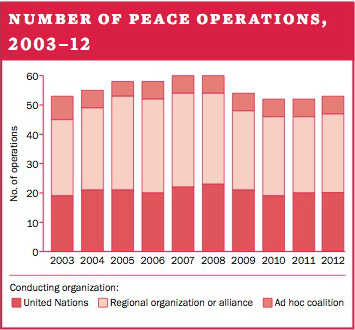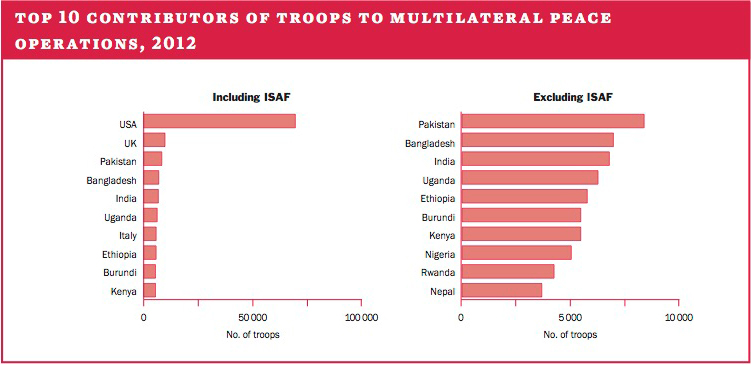2. Peace operations and conflict management
Summary
A total of 53 peace operations were conducted in 2012, one more than in 2011 but still the third lowest number in the period 2003–12. The number of personnel serving with multilateral peace operations worldwide fell by more than 10 per cent in 2012—down by 28 487 to 233 642—as the slight reduction in deployed personnel that started in 2011 gathered pace. The large drop was due to the withdrawal of troops from the International Security Assistance Force (ISAF) in Afghanistan. However, the reductions followed almost a decade of rapid expansion, and the total for deployments was still the third highest since 2003.
Excluding ISAF, deployments increased by 847 personnel. This is the first increase in non-ISAF personnel numbers ISAF since 2008. The small increase in the number of operations between 2011 and 2012 suggests that the trend, which has been downwards since 2009, may be beginning to stabilize.
Austerity led some states to be more critical of spending on peace operations and to increase budget constraints on missions in 2012. The United Nations Security Council increasingly imposed benchmarks and indicators to evaluate existing UN missions’ effectiveness and efficiency, and linked these to future mandate renewals.
Doubts about the capacity and will for protection of civilians (POC) in peace operations were reinforced in 2012 by the perceived failures of UN operations in Côte d’Ivoire, the Democratic Republic of the Congo (DRC) and South Sudan. However, the problem may lie more in unrealistic mandates and expectations. Divisions in the international community were also visible in the response to a military coup in Guinea-Bissau, where the African Union (AU), the European Union (EU) and the UN refused to recognize a transitional government set up through a controversial process mediated by the Economic Community of West African States (ECOWAS).
Despite these doubts, divisions and budget constraints, there is no reason to believe that the number of operations will decrease significantly in the near future, and the number of troops deployed outside Afghanistan is in fact likely to grow. How deep the dip in total personnel deployed will be after the drawdown of ISAF and how diffuse the future picture depend on three factors: the depth of future budget cuts in the West and the extent to which they are allowed to affect the military and peacekeeping capacity; the number of troops that are eventually deployed in Mali, the broader Sahel and potentially Syria; and the extent to which countries are willing to put the responsibility to protect (R2P) and POC into practice rather than simply express outrage over the lack of responsiveness.

Peace operation changes in 2012
Three new missions opened in 2012: the ECOWAS Mission in Guinea-Bissau (ECOMIB), the EU Capacity Building Mission in Niger (EUCAP Sahel Niger) and the UN Supervision Mission in Syria (UNSMIS).
Four missions closed during the year: the EU Police Mission in Bosnia and Herzegovina (EUPM), the UN Integrated Mission in Timor-Leste (UNMIT) and two missions in Syria: the League of Arab States Observer Mission to Syria and UNSMIS, both of which were forced to close due to high levels of violence, which hampered their ability to implement their mandates.

Regional developments
Two operations were active in the Americas in 2012, 8 in Asia and Oceania, 15 in Europe and 11 in the Middle East.
As in previous years, the largest concentration of peace operations was in Africa. There were 17 operations deployed in the region, 9 of them under UN command—a smaller proportion of UN operations than in recent years. The international community took a renewed interest in Somalia; continued to struggle with issues of impartiality and with POC in the DRC; and decided to retain a ‘light footprint’ in Libya.
Transition-related developments and planned withdrawals continued for two operations in Asia and Oceania in 2012: ISAF focused on withdrawing by the end of 2014 and UNMIT closed at the end of 2012.